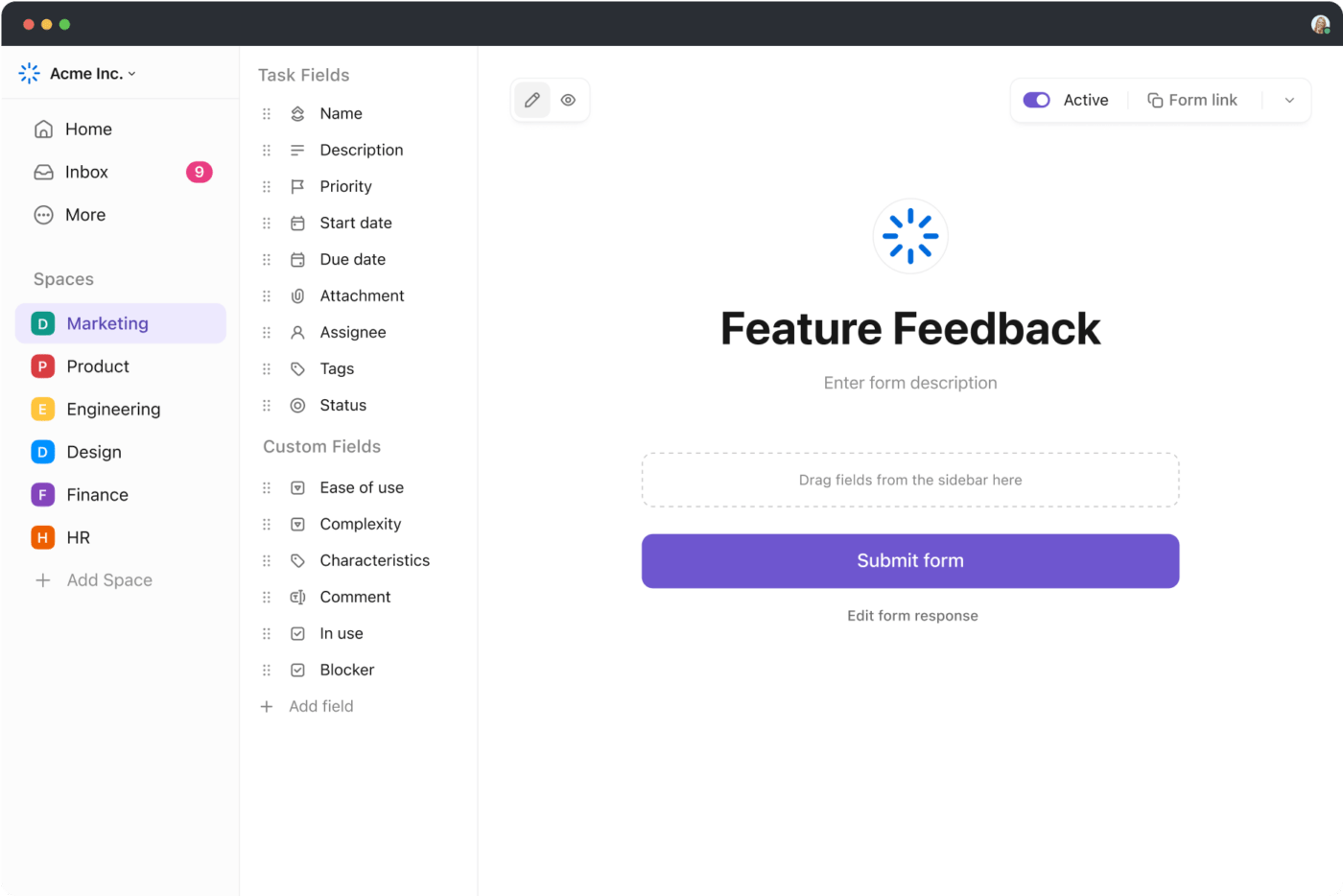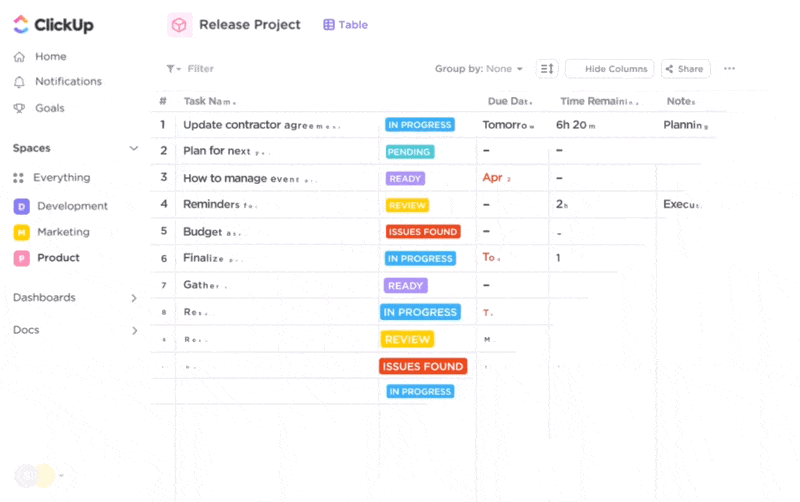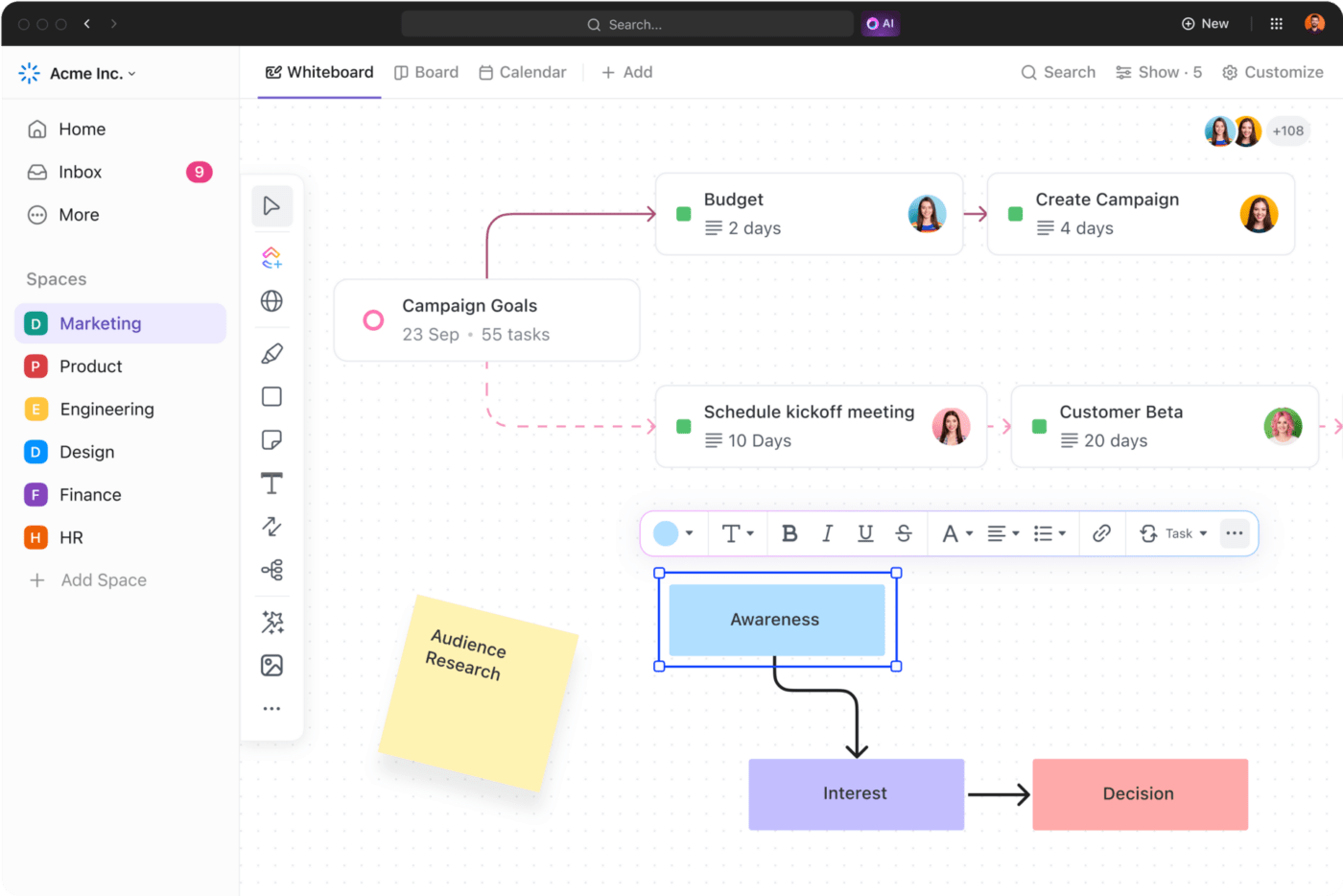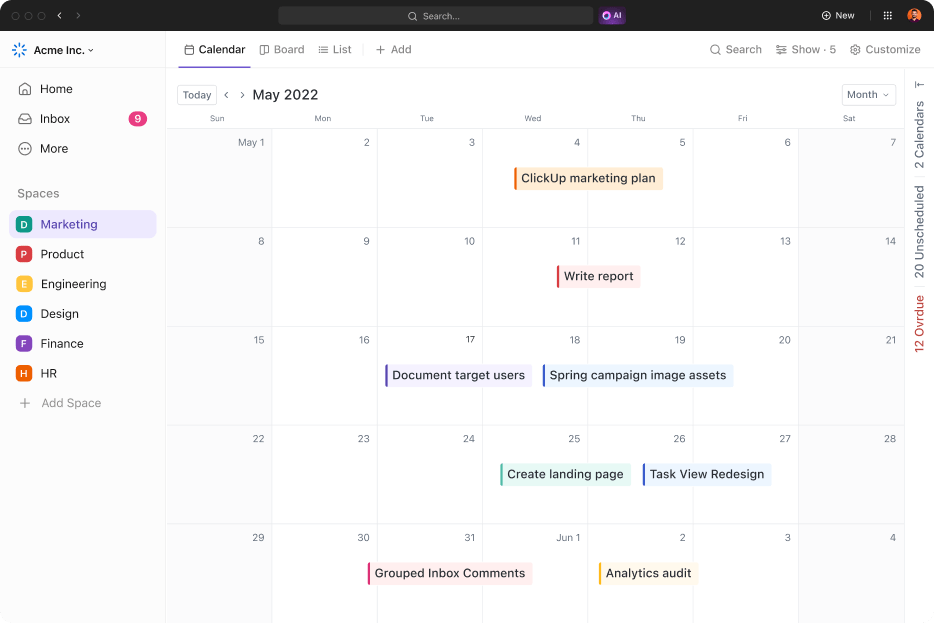لو كان بإمكاننا فقط الحصول على تعويذة سحرية تحول العملاء المحتملين إلى عملاء مخلصين، لكانت كل شركة هي شركة Apple، Inc التالية 🧙♂️
وبما أن هذا ليس هو الحال، يجب عليك اكتشاف استراتيجيات فعالة لزيادة تبني المنتج. يجب أن تبني منتجًا قويًا، وتستثمر في تسويقه، وتعزز مشاركة المستخدمين وتجعلهم ملتصقين بك.
ما هو الالتصاق؟ أفضل تفسير للالتصاق هو كيفية تصفحنا على إنستجرام أو تويتر لساعات طويلة. وهذا ما يجعلنا مستخدمين ملتصقين. إنه حلم كل صاحب منتج.
في هذا الدليل، سنناقش في هذا الدليل كل ما يتعلق بالالتصاق بالمنتج. فإلى جانب الأساسيات اللازمة لفهم المفهوم، سنستكشف طرق قياسه، والتحديات الشائعة وكيفية التغلب عليها، و الاستراتيجيات التي يمكنك تنفيذها لتعزيز تبني المنتج ونجاح العملاء.
ما هو تبني المنتج؟
تبني المنتج، أو تبني المستخدم، هو العملية التي يمر بها عملاؤك قبل أن يقرروا دمج منتجك أو ميزتك الجديدة في حياتهم اليومية أو عملياتهم التجارية. وهو يمثل مجموعة الإجراءات المكتملة التي تدل على أن المستخدمين الجدد قد وجدوا قيمة في المنتج. ✨
يشبه تبني المنتج عملية اكتساب المنتج ولكن لهما أهداف مختلفة:
- الاستحواذ: يركز على الاستكشاف - ما الذي يجلب الزوار إلى موقعك الإلكتروني، وكيف يتعرفون على منتجك، وما الذي يحولهم إلى متبنين مبكرين
- التبني: يركز على الاحتفاظ بالعملاء - ما الذي يحول الزوار إلى مستخدمين
كلا المفهومين ضروريان، لكن تبني المنتج هو الذي يشير إلى نجاح العميل على المدى الطويل. إن وجود العديد من الزوار هو بداية رائعة، لكنه لن يعني الكثير إذا لم يتحول هؤلاء الزوار إلى عملاء مشترين.
أهمية تبني المنتج ## أهمية تبني المنتج
اعتماد المنتج هو اعتماد المنتج عالميًا مؤشر الأداء الرئيسي (KPI) . وهو يساعد فرق المنتج على فهم ما إذا كانت استراتيجية المنتج وجهود التطوير ناجحة. وينعكس ذلك في العديد من مقاييس إدارة المبيعات والمنتجات الأخرى، والتي يشمل بعضها:
- قيمة عمر العميل
- معدل التحويل
- معدل الاحتفاظ بالعملاء
- معدل الاحتفاظ بالعملاء
- درجة مشاركة العملاء
- متوسط الإيرادات الشهرية المتكررة للمستخدمين
- تكاليف اكتساب العملاء
- التكلفة لكل عميل محتمل
الهدف هو تحديد وقياس الإجراءات التي تشير إلى اعتماد المنتج. من خلال القيام بذلك، يمكننا أن نقيّم بموضوعية ما إذا كان منتجنا قد حقق هدفه الأساسي - توفير الفوائد التي صُمم من أجلها.
عندما تعرف ما هي الإجراءات التي تحوّل المستخدمين الجدد إلى مستخدمين على المدى الطويل، يمكنك تحسين المنتج بحيث يكرر المستخدمون الإجراءات المذكورة.
حتى الزيادة الطفيفة في معدل تبني المنتج تكون مؤثرة للغاية. فكلما أسرع المستخدمون في تبني المنتج، كلما وجدوا قيمة في المنتج بشكل أسرع، وكلما زادت القيمة التي سيحصلون عليها بمرور الوقت.
6 مراحل تبنّي المنتج
تمثل عملية تبني المنتج الجديد رحلة العميل من الاكتشاف الأولي إلى الاستخدام المتكرر للمنتج. وتتكون عادةً من المراحل الست التالية:
- الوعي
- الاهتمام
- التقييم
- التجربة
- التفعيل
- التبني
يجب أن تتعامل مع كل مرحلة من مراحل تبني المنتج بنفس المستوى من العناية والاهتمام. فجميعها ضرورية لإيصال المستخدم إلى خط النهاية، وهو الرضا عن المنتج. 🏁
المرحلة 1: الوعي
خلال مرحلة التوعية، يكتشف المستخدمون منتجك وفوائده المحتملة. هذا هو المكان الذي تسويق المنتج خطوات على المنصة
يضمن التسويق تعريف قاعدة المستخدمين المستهدفين بمنتجك وقدرته على حل مشاكلهم. بل إنه في بعض الحالات، يكشف عن المشاكل نفسها.
ولكي تكون جهود تطوير منتجك وجهودك التسويقية فعالة، يجب أن يكون لديك فهم عميق لمشاكل العملاء. 💥
وجود علامة تجارية راسخة ومعروفة يمكن أن تمنحك السبق. إذا كان المستخدمون يثقون بك بالفعل، فسيكونون أكثر استعدادًا لمحاولة تبني منتجك أو ميزتك الجديدة.
المرحلة 2: الاهتمام
إذا كانت حملة التوعية مثمرة وشعر المستخدمون أن منتجك لديه القدرة على إفادةهم، فسيصبحون مهتمين به. سوف يستمرون في استكشاف منتجك، ويقيّمون كيف يساعدهم في أداء وظائفهم (JTBD).
يمكن أن تؤثر العديد من العوامل على اهتمام المستخدمين. على سبيل المثال، يمكن أن يكون اكتشاف المنتج في الوقت المناسب أمرًا محوريًا في قرار المستخدمين بمزيد من الاستكشاف. 🔍
عندما يتعلق الأمر بالحلول المبتكرة وغير التقليدية، فإنك تحتاج إلى الاستثمار أكثر في التسويق لإقناع المستخدمين بالبحث عنها.
مكافأة:
/ href/ https://clickup.com/blog/jobs-to-be-done-templates//** قوالب المهام المطلوب إنجازها /%/href/
!
المرحلة 3: التقييم
في مرحلة التقييم، ينظر المستخدمون إلى منتجك كحل قابل للتطبيق لمشاكلهم. إنهم ينتبهون إلى تكلفته وفوائده الإضافية مثل دعم العملاء . من الضروري جعل جميع المعلومات في متناولهم بسهولة.
سيبحث العملاء والمستخدمون المحتملون أيضًا عن توصيات شفهية ومراجعات عبر الإنترنت. سوف يقارنون منتجك بالخيارات الأخرى في السوق. وأخيراً، سيقررون ما إذا كانوا سيجربون المنتج أم لا.
خلال مرحلة التقييم، يجب عليك التركيز على إبراز مزايا منتجك على منافسيه، مما يتيح لك تحديد موقع المنتج الجهود المبذولة للظهور في المقدمة. يمكن أن يؤدي تقديم الخصومات والمكافآت والتجارب المجانية والعروض التوضيحية المجانية إلى ترجيح كفة الميزان لبعض المستخدمين. ⚖️

استخدم قالب تحديد موقع المنتج الخاص ب ClickUp لتحديد رؤية منتجك ورسالته وشريحة السوق ونقاط الضعف والمزيد
المرحلة 4: التجربة
في هذه المرحلة، يأخذ المستخدمون عينات من منتجك. إنهم يزنون عوامل مثل
- ما إذا كان المنتج يفي بوعوده التسويقية ويحل مشاكلهم
- مدى سهولة استخدام المنتج
- مدى ملاءمة المنتج لمجموعتهم التكنولوجية
يعتمد النجاح في هذه المرحلة على تصميم منتجك ومدى ملاءمته لمجموعتهم التكنولوجية تجربة الإعداد . تأكد من توفير الموارد والدعم الكافي لتسهيل التعرف على قدرات منتجك. 🦸
تحديد مجالات التحسين, استخدام الخرائط الحرارية وتسجيلات الجلسات. كما أن التغذية الراجعة النوعية في شكل مقابلات واستطلاعات رأي قيّمة أيضًا.

استخدم نماذج ClickUp لجمع مدخلات حول احتياجات المستخدمين والحصول على تعليقات على منتجك
المرحلة 5: التفعيل
التفعيل تحدث عندما يكتشف المستخدمون لأول مرة القيمة الحقيقية لمنتجك. هذه المرحلة هي نقطة الانطلاق الضرورية بين الاستكشاف الأولي والتأييد الكامل. 👞
مهمتك هي مساعدة المستخدمين على الوصول إلى مرحلة التفعيل في أقرب وقت ممكن. قد يبدو التفعيل مختلفًا اعتمادًا على ملف تعريف المستخدم، لذلك يجب عليك تعديل جهودك وفقًا لذلك.
يمكنك تسريع العملية من خلال عرض أمثلة على استخدام منتجك وتقديم نماذج لمساعدتهم على البدء بسرعة.

يقدم ClickUp أكثر من 1,000 قالب جاهز، بما في ذلك أكثر من 100 قالب مصمم لفرق المنتجات والهندسة
المرحلة 6: التبني
عندما يتبنى المستخدمون منتجك، فهذا يعني أنهم جعلوه جزءًا منتظمًا من حياتهم الشخصية أو المهنية. السعر الذي دفعوه والجهد الذي استثمروه في استكشافه واختباره قد أثمر الآن. إذا كان المنتج مناسبًا لهم، فقد ينشر العملاء الحاليون الخبر ويصبحون مروجين لعلامتك التجارية. 🗣️
الآن بعد أن اكتسبت ثقة المستخدمين، وجّه جهودك نحو الحفاظ عليها. يمكنك القيام بذلك من خلال استراتيجيات الاحتفاظ بالعملاء ، وبرامج الولاء، والمعالم، و التحسين المستمر للمنتج .
كيفية قياس اعتماد المنتج: أهم مقاييس تبني المنتج
نقيس اعتماد المنتج من خلال معدل اعتماد المنتج، وهو النسبة المئوية للمستخدمين المحتملين الذين أصبحوا مستخدمين منتظمين للمنتج، أي العملاء المخلصين.
يعتبر تبني المنتج مفهومًا معقدًا، لذا فإن قياس نطاقه الحقيقي قد يكون صعبًا. أولاً، يجب عليك تحديد ما الذي يشكل حدث التبني - سلسلة الإجراءات التي تشير إلى قبول المستخدم للمنتج.
لتحديد مدى القيمة التي يحصل عليها العملاء من المنتج، نستخدم العديد من مقاييس تبني المنتج، مثل
- معدل التحويل: النسبة المئوية للمستخدمين الذين أكملوا كلاً من الاشتراك والإجراء الرئيسي الأول الذي يشير إلى التبني
- الوقت اللازم لتحقيق القيمة: مقدار الوقت (دقائق أو نقرات) الذي يحتاجه المستخدمون للحصول على قيمة قابلة للقياس للمنتج الذي اشتروه
- معدل إكمال عملية التأهيل: النسبة المئوية للمستخدمين الذين اجتازوا عملية تأهيل المنتج
- تكرار الاستخدام: تكرار عمليات تسجيل الدخول أو جلسات المستخدم خلال فترة معينة، مما يشير إلى عدد المستخدمين النشطين يوميًا
- تكرار عمليات الشراء: متوسط عدد عمليات الشراء التي يقوم بها المستخدمون خلال فترة محددة
- درجة رضا العميل: مقياس ذاتي للرضا على المدى القصير في نقاط مختلفة في رحلة العميل
- نتيجة المروج الصافي: مقياس ذاتي لمدى احتمالية توصية المستخدم بالمنتج لشخص آخر، مما يشير إلى الرضا والولاء على المدى الطويل
- القيمة الدائمة للعميل: إجمالي الأرباح المحققة من المستخدمين خلال علاقتهم بالمنتج
يمنحنا تحليل مقاييس تبني المنتج الأدوات اللازمة لتتبع وتحليل سلوك المستخدم وتفضيلاته. فهي تسمح لنا بصقل تطوير منتجاتنا استراتيجية لضمان رضا المستخدم المستمر.
التغلب على العقبات التي تعترض عملية تبني المنتج
سنناقش أدناه العقبات الأكثر شيوعًا التي تواجهها الشركات في عملية تبني المنتج ونقترح بعض الحلول:
عدم وضوح رؤية المنتج
لن يتبنّى المستخدمون منتجك إذا لم يعرفوا بوجوده أو يدركوا الحاجة إليه. عادةً ما تكون المنافسة عالية، لذا يجب أن تجد طريقة للتميز وزيادة الوعي بمنتجك. إليك كيفية القيام بذلك:
- تعرف على الفئة السكانية المستهدفة وفهم ما تحتاجه
- ضع تصورًا للمنتج مع مراعاة مدى ملاءمة المنتج للسوق، وخلق عرض قيمة للمستخدمين
- بناء حملات تسويقية فعالة وحملات تثقيفية عن المنتج، مع تسليط الضوء على مزايا المنتج ذات الصلة بالجمهور
من خلال منتج قيّم وتسويق فعّال، يمكنك تحقيق كتلة حرجة حتى قبل إطلاق المنتج، مما يهيئ منتجك للنجاح. 🌟
الصعوبات التقنية
لنفترض أن المستخدمين على دراية بمنتجك ويجدونه واعدًا. يمضون في تجربته بحماس ولكنهم يقابلون تصميمًا مربكًا أو طوفانًا من الميزات أو أخطاء مزعجة. من المحتمل أن يتضاءل حماسهم. لن يقوموا حتى باختبار المنتج، ناهيك عن اعتماده.
للقضاء على هذه المشكلة في مهدها، قم بما يلي:
- استثمر فيتصميم تجربة المستخدم (UX) واختبر منتجك إلى حد الكمال
- تحليل تحليلات المنتج وتعليقات العملاء باستمرار، ثم استخدامها لتحسين المنتج
- إنشاء عملية تأهيل سلسة وقاعدة معرفية شاملة
- توفير دعم ممتاز للعملاء، والرد على استفسارات المستخدمين وحل المشاكل بسرعة
التكلفة العالية وقيود الميزانية
حتى إذا كان المستخدم على دراية بمنتجك ومولعًا به، فلن يتبناه إذا كان سعره مرتفعًا جدًا بالنسبة له، خاصةً إذا كان أحد المنافسين يقدمه بسعر أرخص.
هذه المشكلة منتشرة ويصعب حلها. إن خفض أسعارك ليس ممكنًا دائمًا.
الأمر كله يتعلق بإيجاد هذا التوازن - حساب تكاليف الإنتاج والعمالة ولكن مع جعل المنتج في متناول قاعدة المستخدمين المستهدفين. قد يكون المستخدمون على استعداد لدفع المال إذا كان المنتج فريداً من نوعه ويوفر قيمة عالية. 🪙
4 أفضل الممارسات لتحسين تبني المنتج ## 4 أفضل الممارسات لتحسين تبني المنتج
فيما يلي، سنشاركك بعض النصائح لمساعدتك على تعزيز تبني المنتج. كما ستتعرف أيضًا على كيفية إجراء منصة إدارة المشاريع مثل انقر فوق دعمك خلال كل مرحلة من مراحل عملية اعتماد المنتج.
1. بناء منتج رائع والحفاظ عليه
تبدأ مطاردة تبني المنتج بمفهوم المنتج. لتطوير منتج لا يمكن للمستخدمين العيش بدونه، يجب عليك أولاً فهم نقاط الألم والتفضيلات الخاصة بهم. بعد ذلك، يجب عليك استخدام تلك المعرفة لـ بناء منتج لا بد من امتلاكه وسهل الاستخدام. التنظيم السليم ضروري لأي عملية، خاصةً العمليات المعقدة مثل تطوير المنتجات. A أداة إنتاجية مثل ClickUp يمكن أن تجعل وظيفة مديري المنتجات أسهل وأقل إرهاقاً. ميزات ClickUp لفرق المنتجات متنوعة. يمكن أن يعمل التطبيق كمركز لجميع معارفك ووثائقك وتخطيطك الاستراتيجي, إدارة الإصدار وتتبع السرعة
مع هيكلها الهرمي و مهام النقر فوق المهام ، يمكنك تعيين العمل وجدولته، وتقسيمه إلى مهام فرعية وقوائم تدقيق. اختيار ClickUp لأكثر من 15 طريقة عرض و20 حقل مخصص يتيح لك تخصيص مساحة العمل الخاصة بك لتلبية احتياجاتك.

توفر طرق عرض ClickUp التي يزيد عددها عن 15 طريقة عرض للمؤسسات حلاً لكل فريق من الجدار إلى الجدار
على سبيل المثال، الكلاسيكية عرض لوحة ClickUp Board يجعل من السهل تصور العمل القادم، مثل الإصدارات والتحديثات والمنتجات الحملات التسويقية .

يمكنك الإشراف على المهام والمشروعات في لمحة واحدة وسحب المهام وإفلاتها وفرزها وتصفيتها بسهولة من خلال عرض لوحة كانبان القابلة للتخصيص بالكامل
يمكنك استخدام ClickUp Whiteboards لتبادل الأفكار مع فريقك وصياغة خرائط طريق استراتيجية جذابة وخرائط رحلة المستخدم. 🗺️

قم بعمل خرائط طريق إبداعية وخرائط رحلة المستخدم مع فريقك باستخدام ClickUp Whiteboards نماذج ClickUp تتيح لك إنشاء استبيانات وتوزيعها لجمع معلومات حول احتياجات المستخدمين والأخطاء وملاحظات المنتج. لتوفير الوقت والجهد، يمكن تحويل الردود تلقائيًا إلى مهام. يمكنك اكتشاف المشكلات وحلها على الفور، مما يحافظ على رضا العملاء. يتكامل ClickUp مع مع العديد من أدوات التطوير، مثل GitHub وGitLab وBitBucket، مما يسمح لك بتبسيط سير عمل التطوير الخاص بك.
2. لا تبخل على التسويق
يعد خلق دعاية حول منتجك خطوة ضرورية نحو اعتماده. يجب عليك نشر محتوى مثل المدونات والمنشورات على وسائل التواصل الاجتماعي، وتثقيف الجمهور حول منتجك والمشكلة التي يحاول حلها. يتيح لك القيام بذلك أيضًا بناء السلطة وترسيخ الثقة في شركتك وعلامتك التجارية.
يمكنك استخدام ClickUp لتخطيط حملاتك التسويقية وتنفيذها. صمم محتوى جذابًا باستخدام مستندات ClickUp وخيارات التنسيق الغنية الخاصة به. 🖋️
وفي الوقت نفسه انقر فوق الذكاء الاصطناعي هو مساعدك الموثوق في الكتابة بالذكاء الاصطناعي. في بضع ثوانٍ فقط، يمكنه صياغة الخطوط العريضة للحملة، واقتراح الأفكار، وتلخيص الملاحظات، والتحقق من التدقيق الإملائي لمحتواك التسويقي، وغير ذلك الكثير!

تسهّل وظائف الذكاء الاصطناعي في ClickUp على فرق التسويق إنتاج مستندات مهمة بسرعة مثل دراسة الحالة
يمكنك أيضًا إدارة نشر المحتوى التسويقي الخاص بك داخل التطبيق، مثل عرض تقويم ClickUp بمثابة تقويم للمحتوى. كل ما عليك فعله هو إنشاء مهام المحتوى وسحبها وإفلاتها في التقويم لجدولتها. طريقة العرض قابلة للتخصيص بدرجة كبيرة، مما يسمح لك بالتبديل بين طرق العرض اليومية أو الأسبوعية أو الشهرية وإضافة الألوان والرموز التعبيرية والفلاتر.

تتبع جدولك التسويقي وانشر كل المحتوى الخاص بك في الوقت المحدد باستخدام طريقة عرض التقويم في ClickUp
بمجرد أن يتخطى المستخدمون مرحلة الوعي ويفكرون في تجربة منتجك أو شرائه، من المهم أن تسهل عليهم الحصول على إجابات. يجب عليك تقديم معلومات شاملة على موقعك الإلكتروني وإنشاء محتوى في منتصف وأسفل المسار مثل البرامج التعليمية ومقارنات المنتجات.
3. قياس اعتماد المنتج لتحقيق النجاح
يجب عليك مراقبة أداء منتجك و جمع آراء المستخدمين خلال كل مرحلة من مراحل تطوير المنتج واعتماده. يتيح لك القيام بذلك أن تكون موضوعياً وتتخذ القرارات التي من شأنها دفع منتجك نحو النجاح. 🙌
خلال مرحلة التوعية، استخدم أدوات البحث عن تحسين محركات البحث لتحديد الموضوعات التي تهتم بها قاعدة المستخدمين لديك. تتبع مقاييس اعتماد المنتج مثل مشاهدات الصفحة ومعدل الارتداد لتقييم أداء المحتوى التسويقي.
كلما زاد اهتمام المستخدمين، تتبع عدد المكالمات المحجوزة والعروض التوضيحية والاشتراكات. استخدم خرائط الحرارة وتسجيلات الجلسات لفهم كيفية تفاعل المستخدمين مع منتجك.
يعد جمع المعلومات النوعية أمرًا بالغ الأهمية أيضًا. أنشئ نماذج ClickUp وشاركها من أجل:
- اكتساب رؤى حول احتياجات المستخدمين
- معرفة كيف تعرفوا على شركتك أو ما الذي جعلهم يشتركون فيها
- الحصول على تعليقات العملاء على منتجك
إذا قمت بقياس التقدم خلال تطوير المشروع يمكنك اكتشاف الاختناقات والحصول على أفكار حول تحسين سير عملك. أهداف النقر يسمح لك بتتبع التقدم المحرز نحو أهداف وغايات محددة، في حين أن ClickUp Dashboards تمنحك نظرة عامة في الوقت الفعلي على عملك واستخدامك للموارد. مع أكثر من 50 بطاقة، يمكنك تخصيص لوحة التحكم الخاصة بك لعرض المعلومات التي تحتاجها.

احصل على نظرة عامة سريعة على تقدم عملك وأداء فريقك باستخدام لوحات معلومات ClickUp Dashboards
4. ابقَ على اتصال بالمستخدمين
بعد أن تقوم بتوصيل المستخدمين، افعل ما بوسعك لرعاية الاتصالات.
تواصل مع المستخدمين داخل التطبيق وخارجياً عبر البريد الإلكتروني. قدِّم الدعم أثناء التهيئة، خاصةً إذا كان لمنتجك منحنى اعتماد حاد. تقديم تعزيزات إيجابية لسلوكيات محددة، والاحتفال بكل إنجاز. شارك النصائح، وأطلع المستخدمين على الميزات والتغييرات الجديدة، وقدم برامج الولاء والخصومات كوسيلة للتعبير عن الشكر. 🙏
سيؤدي القيام بذلك إلى توطيد علاقتك، مما يضمن تحول المستخدمين من متبنين مبكرين إلى مناصرين
تعزيز وتسريع تبني المنتج باستخدام ClickUp
إن تبني المنتج ليس مفهومًا سهل الفهم والتأثير. ولكن وجود خطة مدروسة وسير عمل فعال يمكن أن يساعد في ذلك. A أداة إدارة المنتج مثل ClickUp تساعدك في جهودك، وتعزز الإنتاجية وتعاون الفريق في جميع المجالات.
مع سير عملك بشكل منظم، ومنتج ممتاز ومتطور، وتقييم مستمر للأداء، سيبرز منتجك في السوق التنافسي وسيظل المستخدمون راضين عنه. 😊 اشترك في ClickUp واكتشف جميع الطرق التي يمكن أن تضمن تطوير المنتج واعتماده بسلاسة.

